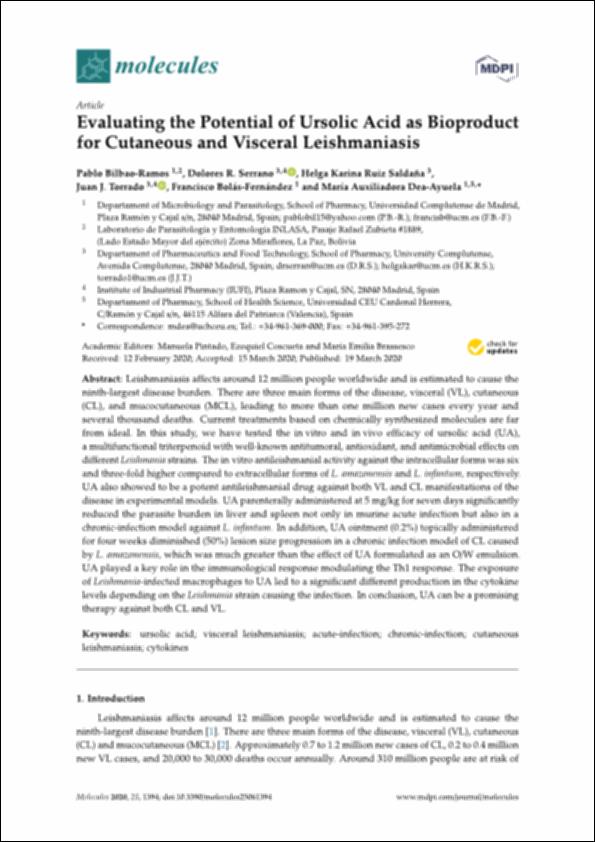Please use this identifier to cite or link to this item:
http://hdl.handle.net/10637/12673Evaluating the potential of Ursolic Acid as bioproduct for cutaneous and visceral leishmaniasis
| Title: | Evaluating the potential of Ursolic Acid as bioproduct for cutaneous and visceral leishmaniasis |
| Authors : | Bilbao Ramos, Pablo Serrano López, Dolores Remedios Ruiz Saldaña, Helga Karina Torrado Durán, Juan José Bolás Fernández, Francisco Dea Ayuela, María Auxiliadora |
| Keywords: | Leishmaniasis - Tratamiento.; Leishmaniasis - Treatment.; Enfermedades infecciosas - Tratamiento.; Ursolic acid - Therapeutic use.; Ácido ursólico - Uso terapéutico.; Citoquina.; Cytokines.; Communicable diseases - Treatment. |
| Publisher: | MDPI. |
| Citation: | Bilbao-Ramos, P., Serrano, D.R., Ruiz Saldaña, H.K., Torrado, J.J., Bolás-Fernández, F. & Dea-Ayuela, M.A. (2020). Evaluating the potential of Ursolic Acid as bioproduct for cutaneous and visceral leishmaniasis. Molecules, vol. 25, i. 6 (19 mar.), art. 1394. DOI: https://doi.org/10.3390/molecules25061394 |
| Abstract: | Leishmaniasis a ects around 12 million people worldwide and is estimated to cause the ninth-largest disease burden. There are three main forms of the disease, visceral (VL), cutaneous (CL), and mucocutaneous (MCL), leading to more than one million new cases every year and several thousand deaths. Current treatments based on chemically synthesized molecules are far from ideal. In this study, we have tested the in vitro and in vivo e cacy of ursolic acid (UA), a multifunctional triterpenoid with well-known antitumoral, antioxidant, and antimicrobial e ects on di erent Leishmania strains. The in vitro antileishmanial activity against the intracellular forms was six and three-fold higher compared to extracellular forms of L. amazonensis and L. infantum, respectively. UA also showed to be a potent antileishmanial drug against both VL and CL manifestations of the disease in experimental models. UA parenterally administered at 5 mg/kg for seven days significantly reduced the parasite burden in liver and spleen not only in murine acute infection but also in a chronic-infection model against L. infantum. In addition, UA ointment (0.2%) topically administered for four weeks diminished (50%) lesion size progression in a chronic infection model of CL caused by L. amazonensis, which was much greater than the e ect of UA formulated as an O/W emulsion. UA played a key role in the immunological response modulating the Th1 response. The exposure of Leishmania-infected macrophages to UA led to a significant di erent production in the cytokine levels depending on the Leishmania strain causing the infection. In conclusion, UA can be a promising therapy against both CL and VL. |
| Description: | Este artículo se encuentra disponible en la siguiente URL: https://www.mdpi.com/1420-3049/25/6/1394 Este artículo pertenece al número especial "Bioproducts for health". |
| URI: | http://hdl.handle.net/10637/12673 |
| Rights : | http://creativecommons.org/licenses/by/4.0/deed.es |
| ISSN: | 1420-3049 (Electrónico). |
| Issue Date: | 19-Mar-2020 |
| Center : | Universidad Cardenal Herrera-CEU |
| Appears in Collections: | Dpto. Farmacia |
Items in DSpace are protected by copyright, with all rights reserved, unless otherwise indicated.


